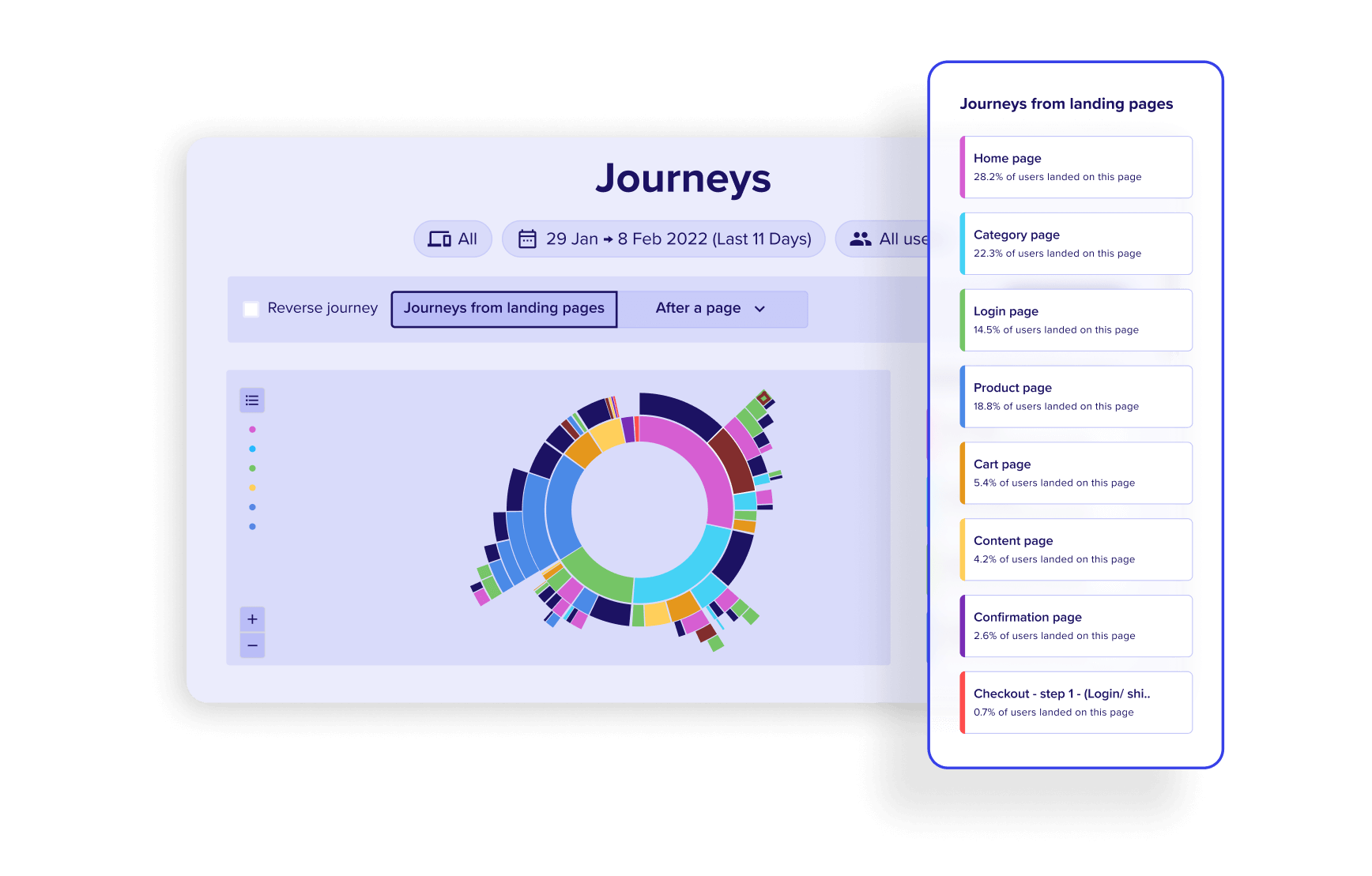
Intuitive visualizations of your customers journey.

User Experience Analysis, often shortened to UX Analysis, is a methodical process that evaluates the interaction between a product or service and its users. This evaluation is performed using a variety of methods, such as user feedback, usability testing, and heuristic evaluations. UX Analysis plays an essential role in the development process of a product, providing valuable insights into user behavior, preferences, and needs.
These insights are then utilized in the design and development process, ensuring the product is user-friendly and meets user expectations, thus enhancing customer satisfaction. UX Analysis is not a one-off process, but rather a continuous one, requiring regular updates and revisions to keep up with evolving user needs and market trends. It is a multidisciplinary field, incorporating elements from psychology, computer science, and design, aiming to understand and optimize the interaction between users and products.
The ultimate goal of UX Analysis is to enhance user satisfaction by improving the usability, accessibility, and pleasure provided in the interaction with a product, often achieved through website optimization and user interface design.
The process of UX Analysis involves several crucial steps. Initially, the user base is identified, followed by the collection of data through user feedback, surveys, and usability testing. This data is then analyzed to identify patterns and trends, which are used to develop user personas and user journey mapping. These tools aid in understanding the user’s perspective, providing valuable insights into their needs and expectations. Based on these insights, recommendations are made to improve the product’s user experience, often involving interaction design changes.
User Experience Analysis is a systematic examination of how users interact with a product or service. It involves studying user behavior, understanding their needs and preferences, and evaluating the product’s performance in meeting these needs.
The objective is to identify areas of improvement and recommend changes to enhance the overall user experience. The process includes various techniques such as usability testing, user feedback, and heuristic evaluations. UX Analysis is a critical aspect of web design and development. It provides insights into the user’s perspective, helping to shape the product in a way that meets their needs and expectations. The process involves a deep understanding of the user, their behavior, and their interaction with the product. This understanding is achieved through a combination of qualitative and quantitative UX research methods.
The insights gained from UX Analysis are used to inform the design and development process. They help to identify potential issues with the product’s usability, accessibility, and overall user experience. By addressing these issues, the product can be refined to provide a more satisfying and engaging user experience. In essence, UX Analysis serves to bridge the gap between the user and the product, ensuring that the product is not only functional but also enjoyable to use.

Intuitive visualizations of your customers journey.
User Experience Analysis is crucial for several reasons. Firstly, it helps to ensure that a product or service is user-friendly and meets the needs and expectations of its users. By understanding the user’s perspective, companies can design and develop products that are not only functional but also enjoyable to use. This leads to increased customer satisfaction, which can result in higher customer retention rates and positive word-of-mouth referrals. Secondly, UX Analysis can provide valuable insights into how to improve a product’s usability and functionality. By identifying potential issues and areas of improvement, companies can make necessary adjustments to enhance the product’s user experience. This can lead to increased user engagement, higher conversion rates, and ultimately, a more successful product.
UX metrics are often used to measure these improvements, providing quantifiable evidence of the product’s success.
Finally, UX Analysis can help to inform strategic decision-making. By understanding the user’s needs and preferences, companies can make informed decisions about product features, design elements, and marketing strategies. This can help to ensure that the product is aligned with the target market’s needs, leading to increased market share and competitive advantage. In short, UX Analysis is a vital tool for any company looking to create a successful, user-centric product.

Intuitive visualizations of your customers journey.
User analysis, a critical process in user interface design and website optimization, necessitates the involvement of various professionals within an organization. Predominantly, User Experience (UX) researchers take the lead.
These experts are proficient in understanding user behavior, needs, and motivations. They use a range of research methods, including usability testing and user feedback collection, to gather valuable data about users.
The insights gained from this data are instrumental in ensuring that the products or services align with the needs and expectations of the target user base. Product Managers also play a significant role in conducting user analysis.
Equipped with a deep understanding of the market and user requirements, they collaborate closely with UX researchers. This collaboration involves defining key user personas, identifying their pain points through interaction design, and uncovering opportunities for product enhancement. Their joint efforts ensure that the product roadmap aligns with user needs, thereby maximizing the potential for customer satisfaction.
The responsibility of conducting user analysis extends to other roles within an organization, depending on its resources and structure. Business Analysts, for instance, may be involved in this process, leveraging their analytical skills to interpret user data and provide strategic recommendations for website optimization. Data Scientists, on the other hand, can contribute by applying advanced statistical techniques to user data, uncovering patterns and trends that can inform web design and UX metrics.
Marketing teams also participate in user analysis. They utilize user data to tailor marketing campaigns, optimize customer engagement, and enhance brand loyalty.
By understanding the needs and behaviors of users through user journey mapping, they can craft messages that resonate with the target audience, driving user acquisition and retention. In conclusion, conducting a user analysis is a multidisciplinary task that requires the involvement of various professionals. Their collective efforts facilitate a thorough understanding of the user, driving user-centric product development and business strategy. This comprehensive approach not only improves the quality of the product or service offered but also contributes to the overall success of the organization.

Intuitive visualizations of your customers journey.